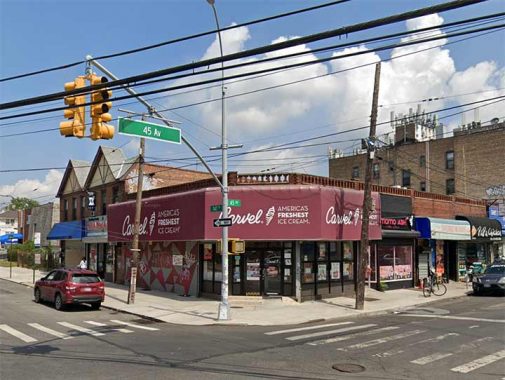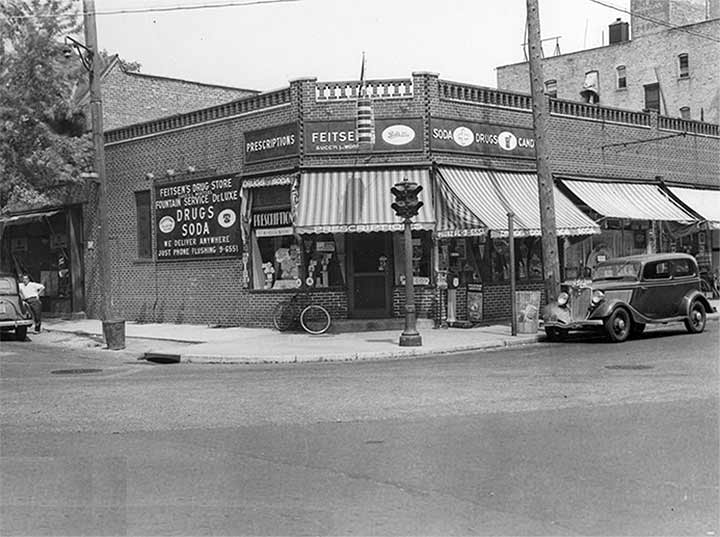
HERE’S a 1930s look at Feitsen’s Drug Store in the 1930s, on 45th Avenue and 147th Street. Out of the picture across the street are Parsons Boulevard and Flushing Hospital (where I was looked at for bronchitis in 2000). This was a good 60 years before I arrived in the area. At the time, 45th Avenue was served by a trolley line that later turned into the Q65 bus.
I have always been perplexed by drug stores, which almost never sell only prescription drugs. Many sold (and some perhaps still do) sell cigarettes by the pack and by the box — the very cigarettes that cause the diseases that drugs are made to combat. Many double as groceries, with drinks, snacks, cosmetics, aisles and aisles of them, with only a couple of aisles given over to health-related items.
As we see above, drugstores also doubled as soda fountains in the old days, with elaborate setups of marble stands behind which stood white-coated and white-capped soda jerks ready to dispense ice cream sodas and egg creams. All this, to me, seemed a far cry from the other items on sale there: compunds produced in laboratories that alleviated sicknesses. How did the two ever get combined like this?

By 2022, the corner had changed; the small two-color stoplight that was enough to control traffic has become a two-directional guy-wired stoplight. The drugstore building remains…you can tell by the roofline…but it’s now a Carvel franchise. Thus, things have come full circle. The common denominator is ice cream, which was available here in the 1930s and in 2022. As for the drugs, there’s a pharmacy across on Parsons Boulevard, as you would expect near a hospital.
As always, “comment…as you see fit.” I earn a small payment when you click on any ad on the site. Take a look at the new JOBS link in the red toolbar at the top of the page on the desktop version, as I also get a small payment when you view a job via that link.
7/1/24


7 comments
“The common denominator is ice cream,…”
And the bicycles resting in front of the stores, and the telephone poles on both 45th and 147th. The pole on the left could be the same pole that is in the earlier photo.
You should start taking photos of telephone poles. They might start disappearing soon since cell phones now abound.
Also, street wastebaskets seem to be a thing of the past even though they are greatly needed these days.
I could, but I’d be even more of an ultra nerd than now.
As if that ever stopped me.
Just some guesses about why old-style drug stores often had soda fountains. Before home freezers became common, ice cream had to be consumed quickly, so that when drug store customers were getting prescriptions or other health items, they were already a captive audience for a product that was often not found at home – ice cream. Customer could take home ice cream that would be packed into a white cardboard container – but it had to be consumed quickly unless a freezer was available at home. And another thought – if a person was picking up medications because of illness, why not get something pleasurable as well, such as ice cream.
I remember pharmacies with soda fountains as recently as the mid-1960s, but once Carvel and Baskin-Robbins entered the market with a dozen or more flavors, the neighborhood soda fountain became obsolete.
Another commodity they dispensed was cocoa cola syrup, used for stomach issues. How times have changed
A short article detailing the history of soda fountains and drug stores: https://www.pharmacytimes.com/view/soda-fountains–their-pharmacist-inventors
Besides churches and movie theaters,the only places in town open on sundays.And you
could buy cigarettes individually.
Many old style drug stores made tonics which were served on the spot mixed with syrup and seltzer to make them more palatable. This continued a long history of making sweet candies out of bitter herbs to treat various ailments. Coca-Cola and 7-Up were both formulated as medicated drinks (recommended for absurd numbers of health conditions) before government health regulations required the removal of the medically active ingredients. Root beer was also made to treat conditions. Cel-Ray was another.